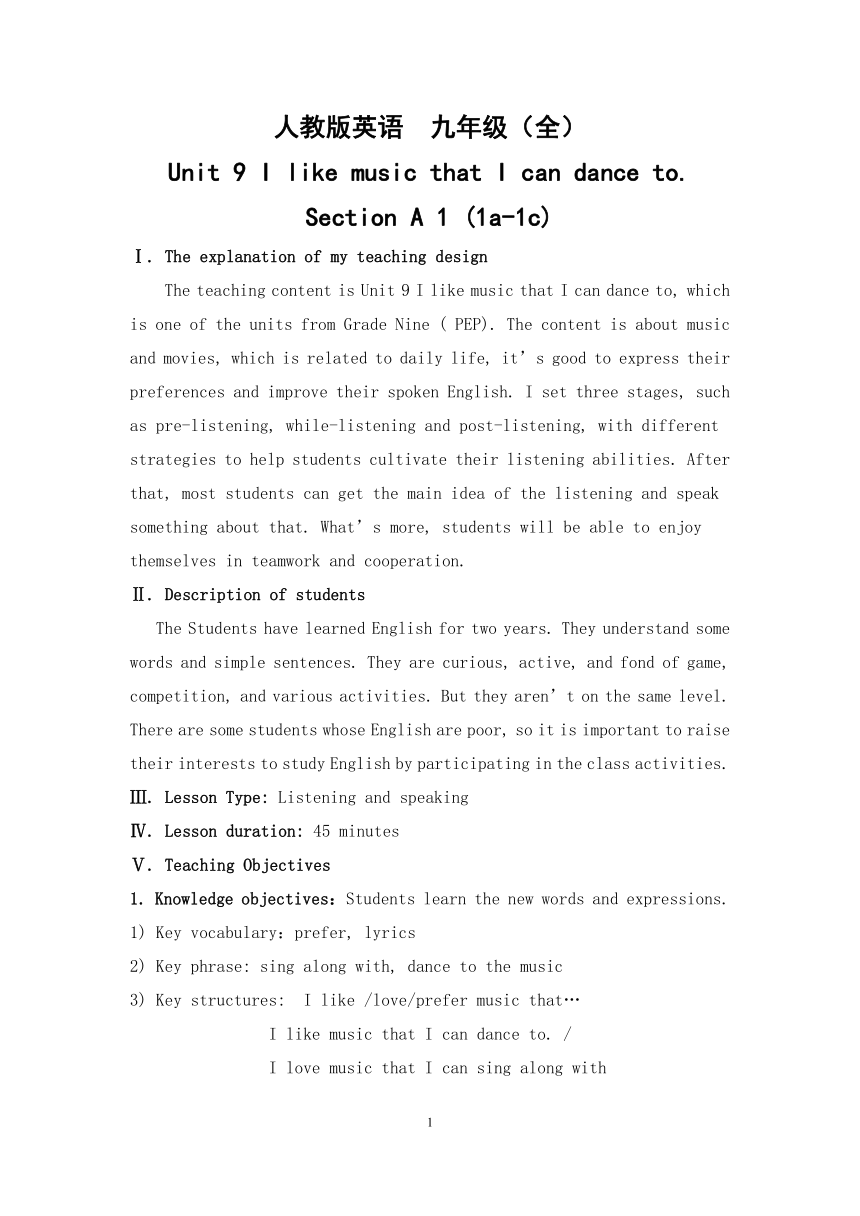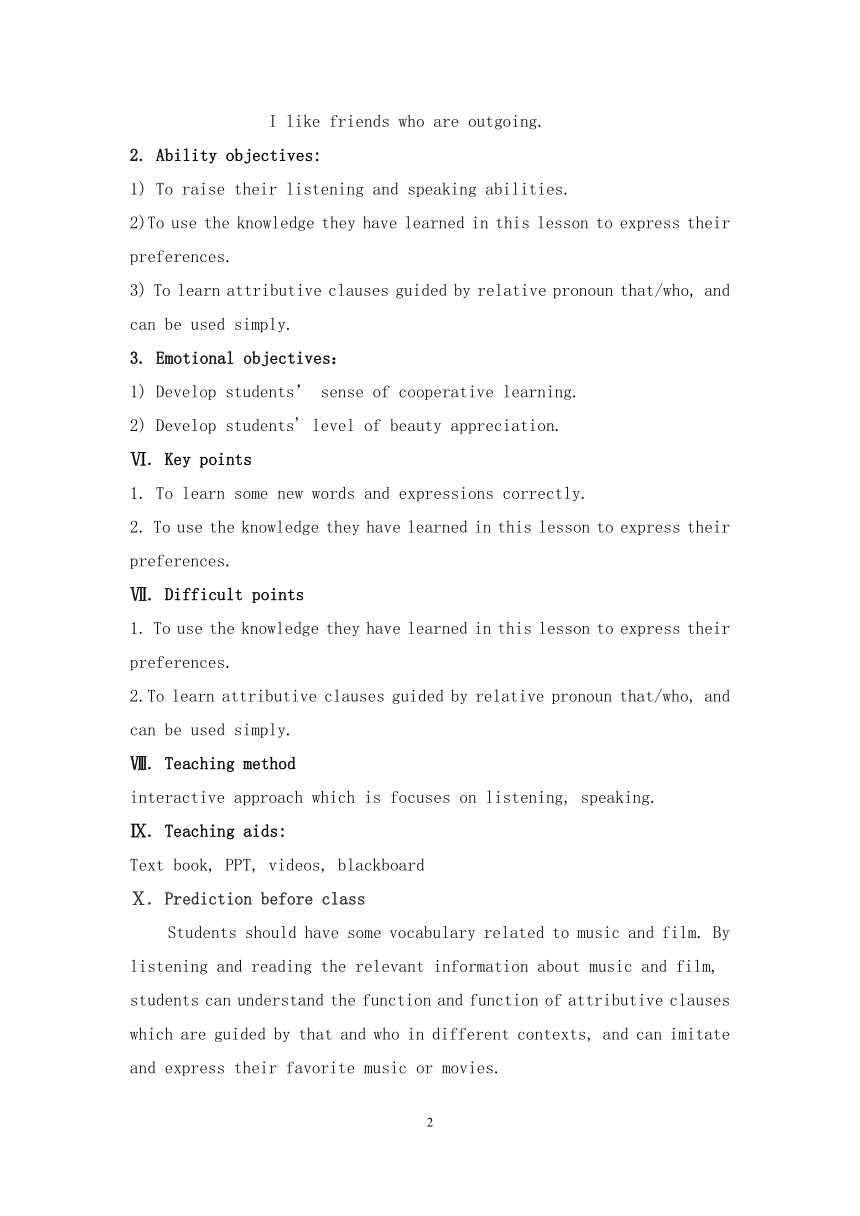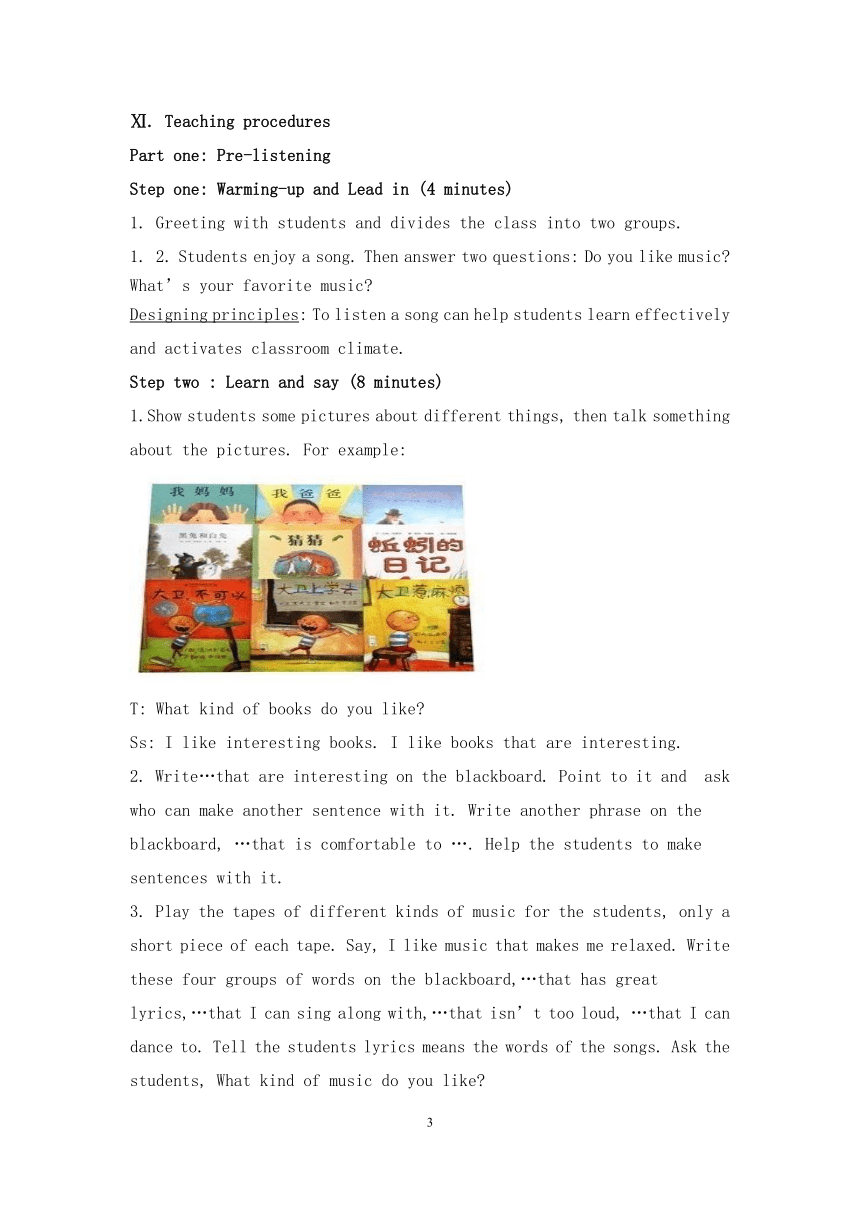9年级人教版全一册 Unit 9 I like the music that I can dance to. Section A 1 (1a-1c) 教案
文档属性
| 名称 | 9年级人教版全一册 Unit 9 I like the music that I can dance to. Section A 1 (1a-1c) 教案 |

|
|
| 格式 | zip | ||
| 文件大小 | 49.6KB | ||
| 资源类型 | 教案 | ||
| 版本资源 | 人教新目标(Go for it)版 | ||
| 科目 | 英语 | ||
| 更新时间 | 2023-01-18 14:58:07 | ||
图片预览



文档简介
人教版英语 九年级(全)
Unit 9 I like music that I can dance to.
Section A 1 (1a-1c)
Ⅰ. The explanation of my teaching design
The teaching content is Unit 9 I like music that I can dance to, which is one of the units from Grade Nine ( PEP). The content is about music and movies, which is related to daily life, it’s good to express their preferences and improve their spoken English. I set three stages, such as pre-listening, while-listening and post-listening, with different strategies to help students cultivate their listening abilities. After that, most students can get the main idea of the listening and speak something about that. What’s more, students will be able to enjoy themselves in teamwork and cooperation.
Ⅱ. Description of students
The Students have learned English for two years. They understand some words and simple sentences. They are curious, active, and fond of game, competition, and various activities. But they aren’t on the same level. There are some students whose English are poor, so it is important to raise their interests to study English by participating in the class activities.
Ⅲ. Lesson Type: Listening and speaking
Ⅳ. Lesson duration: 45 minutes
Ⅴ. Teaching Objectives
1. Knowledge objectives:Students learn the new words and expressions.
1) Key vocabulary:prefer, lyrics
2) Key phrase: sing along with, dance to the music
3) Key structures: I like /love/prefer music that…
I like music that I can dance to. /
I love music that I can sing along with
I like friends who are outgoing.
2. Ability objectives:
1) To raise their listening and speaking abilities.
2)To use the knowledge they have learned in this lesson to express their preferences.
3) To learn attributive clauses guided by relative pronoun that/who, and can be used simply.
3. Emotional objectives:
1) Develop students’ sense of cooperative learning.
2) Develop students' level of beauty appreciation.
Ⅵ. Key points
1. To learn some new words and expressions correctly.
2. To use the knowledge they have learned in this lesson to express their preferences.
Ⅶ. Difficult points
1. To use the knowledge they have learned in this lesson to express their preferences.
2.To learn attributive clauses guided by relative pronoun that/who, and can be used simply.
Ⅷ. Teaching method
interactive approach which is focuses on listening, speaking.
Ⅸ. Teaching aids:
Text book, PPT, videos, blackboard
Ⅹ. Prediction before class
Students should have some vocabulary related to music and film. By listening and reading the relevant information about music and film, students can understand the function and function of attributive clauses which are guided by that and who in different contexts, and can imitate and express their favorite music or movies.
Ⅺ. Teaching procedures
Part one: Pre-listening
Step one: Warming-up and Lead in (4 minutes)
1. Greeting with students and divides the class into two groups.
2. Students enjoy a song. Then answer two questions: Do you like music
What’s your favorite music
Designing principles: To listen a song can help students learn effectively and activates classroom climate.
Step two : Learn and say (8 minutes)
1.Show students some pictures about different things, then talk something about the pictures. For example:
T: What kind of books do you like
Ss: I like interesting books. I like books that are interesting.
2. Write…that are interesting on the blackboard. Point to it and ask who can make another sentence with it. Write another phrase on the blackboard, …that is comfortable to …. Help the students to make sentences with it.
3. Play the tapes of different kinds of music for the students, only a short piece of each tape. Say, I like music that makes me relaxed. Write these four groups of words on the blackboard,…that has great lyrics,…that I can sing along with,…that isn’t too loud, …that I can dance to. Tell the students lyrics means the words of the songs. Ask the students, What kind of music do you like
Say, You can answer with I like music…, I love music…, I prefer music… Explain prefer=like…better to them. Get one of the children to answer the question, then let this child ask the one next to him/her the same question. Set off a chain drill. Explain that I like music that isn’t means that I don’t like too loud music.
Designing principles: Playing more popular songs with lyrics or singers' pictures, it stimulate students' interest of learning, and dialogue between teachers and students, lead to the content learning of this lesson, and pave the way for the completion of 1A
Part two:While- listening
Step three: Work on 1b (7 minutes)
1. Students scan the activity requirements of 1b, the key information needed to be heard: the name of the person and the type of music that he likes.
2. Play the first recording, the students complete the 1b activity independently, and then check the answers together.
3. Play the second recording and ask the students to answer some questions:
a. What does Tony think of the Cool Kids
b. What kind of music does Tony prefer
c. What’s his favorite band
4. Play the tape again, let the students follow that, prompting the students to imitate the pronunciation intonation
Designing principles: To train the ability of listening. And help students to overcome the difficulties in listening.
Part three: Post- listening (8 minutes)
Students read the original text and draw sentences that contain attributive clauses.
2. Show some pictures in PPT and learn the attributive clauses that are guided by the relative pronouns that and who.
3. Learn attributive clauses guided by relative pronoun that/who.
Designing principles: To learn attributive clauses guided by relative pronoun that/who, and can be used simply.
Step four: Pair work (4 minutes)
Finish 1c. Make a conversation between you and your partner about the music that you like.
A: What kind of music do you like
B: I like music that I can sing along with. What about you
A: I prefer music that has great lyrics.
Designing principles: To improve students’ speaking ability.
Step five: Do exercises (3 minutes)
prefer, that, what, who, with, has
A: 1) _______ kind of music do you like
B: I like music 2) _______ I can sing along 3)_______ . What about you
A: I 4) _______ music that 5) _______ great lyrics. And how about musicians
B: Well, I love musicians 6) _______ play different kinds of music.
A: Me, too.
Designing principles: Help students to overcome the difficulties in English learning.
Step six: Play a game (7 minutes)
1.A PPT contains ten numbers, each number contains different contents. Students finish it in a group race.
2. Select the winning team.
Designing principles: Playing games can stimulate students' interest and achieve the goal of consolidating knowledge.
Step seven: Summary (3 minutes)
Let Ss talk about what they have learnt in class.
Step eight: Homework (1 minutes)
1. Write down Attributive Clauses as many as you can (at least five sentences).
2. Preview the new words and expressions.
Designing principles: To prepare for the next lesson.
Ⅻ Blackboard Design:
Key words and expressions:prefer, lyrics, sing along with, dance to the music2)I like /love/prefer music that…I like music that I can dance to. / I love music that I can sing along with I like friends who are outgoing.
Evaluation and Reflection:
In this lesson, I lead the students understand the topic step by step, and train their speaking and listening abilities. In teaching this listening, I want to show the useful listening strategies, like pre-listening, while-listening and post-listening. In class, the teacher is just a guide, while the Ss are the center, where the teacher just join them, giving suggestions, and offering help when they need.
For the time limited, there must be some mistakes in my interpretation; I hope you can give me some suggestions.
4
Unit 9 I like music that I can dance to.
Section A 1 (1a-1c)
Ⅰ. The explanation of my teaching design
The teaching content is Unit 9 I like music that I can dance to, which is one of the units from Grade Nine ( PEP). The content is about music and movies, which is related to daily life, it’s good to express their preferences and improve their spoken English. I set three stages, such as pre-listening, while-listening and post-listening, with different strategies to help students cultivate their listening abilities. After that, most students can get the main idea of the listening and speak something about that. What’s more, students will be able to enjoy themselves in teamwork and cooperation.
Ⅱ. Description of students
The Students have learned English for two years. They understand some words and simple sentences. They are curious, active, and fond of game, competition, and various activities. But they aren’t on the same level. There are some students whose English are poor, so it is important to raise their interests to study English by participating in the class activities.
Ⅲ. Lesson Type: Listening and speaking
Ⅳ. Lesson duration: 45 minutes
Ⅴ. Teaching Objectives
1. Knowledge objectives:Students learn the new words and expressions.
1) Key vocabulary:prefer, lyrics
2) Key phrase: sing along with, dance to the music
3) Key structures: I like /love/prefer music that…
I like music that I can dance to. /
I love music that I can sing along with
I like friends who are outgoing.
2. Ability objectives:
1) To raise their listening and speaking abilities.
2)To use the knowledge they have learned in this lesson to express their preferences.
3) To learn attributive clauses guided by relative pronoun that/who, and can be used simply.
3. Emotional objectives:
1) Develop students’ sense of cooperative learning.
2) Develop students' level of beauty appreciation.
Ⅵ. Key points
1. To learn some new words and expressions correctly.
2. To use the knowledge they have learned in this lesson to express their preferences.
Ⅶ. Difficult points
1. To use the knowledge they have learned in this lesson to express their preferences.
2.To learn attributive clauses guided by relative pronoun that/who, and can be used simply.
Ⅷ. Teaching method
interactive approach which is focuses on listening, speaking.
Ⅸ. Teaching aids:
Text book, PPT, videos, blackboard
Ⅹ. Prediction before class
Students should have some vocabulary related to music and film. By listening and reading the relevant information about music and film, students can understand the function and function of attributive clauses which are guided by that and who in different contexts, and can imitate and express their favorite music or movies.
Ⅺ. Teaching procedures
Part one: Pre-listening
Step one: Warming-up and Lead in (4 minutes)
1. Greeting with students and divides the class into two groups.
2. Students enjoy a song. Then answer two questions: Do you like music
What’s your favorite music
Designing principles: To listen a song can help students learn effectively and activates classroom climate.
Step two : Learn and say (8 minutes)
1.Show students some pictures about different things, then talk something about the pictures. For example:
T: What kind of books do you like
Ss: I like interesting books. I like books that are interesting.
2. Write…that are interesting on the blackboard. Point to it and ask who can make another sentence with it. Write another phrase on the blackboard, …that is comfortable to …. Help the students to make sentences with it.
3. Play the tapes of different kinds of music for the students, only a short piece of each tape. Say, I like music that makes me relaxed. Write these four groups of words on the blackboard,…that has great lyrics,…that I can sing along with,…that isn’t too loud, …that I can dance to. Tell the students lyrics means the words of the songs. Ask the students, What kind of music do you like
Say, You can answer with I like music…, I love music…, I prefer music… Explain prefer=like…better to them. Get one of the children to answer the question, then let this child ask the one next to him/her the same question. Set off a chain drill. Explain that I like music that isn’t means that I don’t like too loud music.
Designing principles: Playing more popular songs with lyrics or singers' pictures, it stimulate students' interest of learning, and dialogue between teachers and students, lead to the content learning of this lesson, and pave the way for the completion of 1A
Part two:While- listening
Step three: Work on 1b (7 minutes)
1. Students scan the activity requirements of 1b, the key information needed to be heard: the name of the person and the type of music that he likes.
2. Play the first recording, the students complete the 1b activity independently, and then check the answers together.
3. Play the second recording and ask the students to answer some questions:
a. What does Tony think of the Cool Kids
b. What kind of music does Tony prefer
c. What’s his favorite band
4. Play the tape again, let the students follow that, prompting the students to imitate the pronunciation intonation
Designing principles: To train the ability of listening. And help students to overcome the difficulties in listening.
Part three: Post- listening (8 minutes)
Students read the original text and draw sentences that contain attributive clauses.
2. Show some pictures in PPT and learn the attributive clauses that are guided by the relative pronouns that and who.
3. Learn attributive clauses guided by relative pronoun that/who.
Designing principles: To learn attributive clauses guided by relative pronoun that/who, and can be used simply.
Step four: Pair work (4 minutes)
Finish 1c. Make a conversation between you and your partner about the music that you like.
A: What kind of music do you like
B: I like music that I can sing along with. What about you
A: I prefer music that has great lyrics.
Designing principles: To improve students’ speaking ability.
Step five: Do exercises (3 minutes)
prefer, that, what, who, with, has
A: 1) _______ kind of music do you like
B: I like music 2) _______ I can sing along 3)_______ . What about you
A: I 4) _______ music that 5) _______ great lyrics. And how about musicians
B: Well, I love musicians 6) _______ play different kinds of music.
A: Me, too.
Designing principles: Help students to overcome the difficulties in English learning.
Step six: Play a game (7 minutes)
1.A PPT contains ten numbers, each number contains different contents. Students finish it in a group race.
2. Select the winning team.
Designing principles: Playing games can stimulate students' interest and achieve the goal of consolidating knowledge.
Step seven: Summary (3 minutes)
Let Ss talk about what they have learnt in class.
Step eight: Homework (1 minutes)
1. Write down Attributive Clauses as many as you can (at least five sentences).
2. Preview the new words and expressions.
Designing principles: To prepare for the next lesson.
Ⅻ Blackboard Design:
Key words and expressions:prefer, lyrics, sing along with, dance to the music2)I like /love/prefer music that…I like music that I can dance to. / I love music that I can sing along with I like friends who are outgoing.
Evaluation and Reflection:
In this lesson, I lead the students understand the topic step by step, and train their speaking and listening abilities. In teaching this listening, I want to show the useful listening strategies, like pre-listening, while-listening and post-listening. In class, the teacher is just a guide, while the Ss are the center, where the teacher just join them, giving suggestions, and offering help when they need.
For the time limited, there must be some mistakes in my interpretation; I hope you can give me some suggestions.
4
同课章节目录
- Unit 1 How can we become good learners.
- Section A
- Section B
- Unit 2 I think that mooncakes are delicious!
- Section A
- Section B
- Unit 3 Could you please tell me where the restroom
- Section A
- Section B
- Unit 4 I used to be afraid of the dark.
- Section A
- Section B
- Unit 5 What are the shirts made of?
- Section A
- Section B
- Review of Units 1-5
- Unit 6 When was it invented?
- Section A
- Section B
- Unit 7 Teenagers should be allowed to choose their
- Section A
- Section B
- Unit 8 It must belong to Carla.
- Section A
- Section B
- Unit 9 I like music that I can dance to.
- Section A
- Section B
- Unit 10 You're supposed to shake hands.
- Section A
- Section B
- Review of Units 6-10
- Unit 11 Sad movies make me cry.
- Section A
- Section B
- Unit 12 Life is full of the unexpected
- Section A
- Section B
- Unit 13 We're trying to save the earth!
- Section A
- Section B
- Unit 14 I remember meeting all of you in Grade 7.
- Section A
- Section B
- Review of Units 11-14
